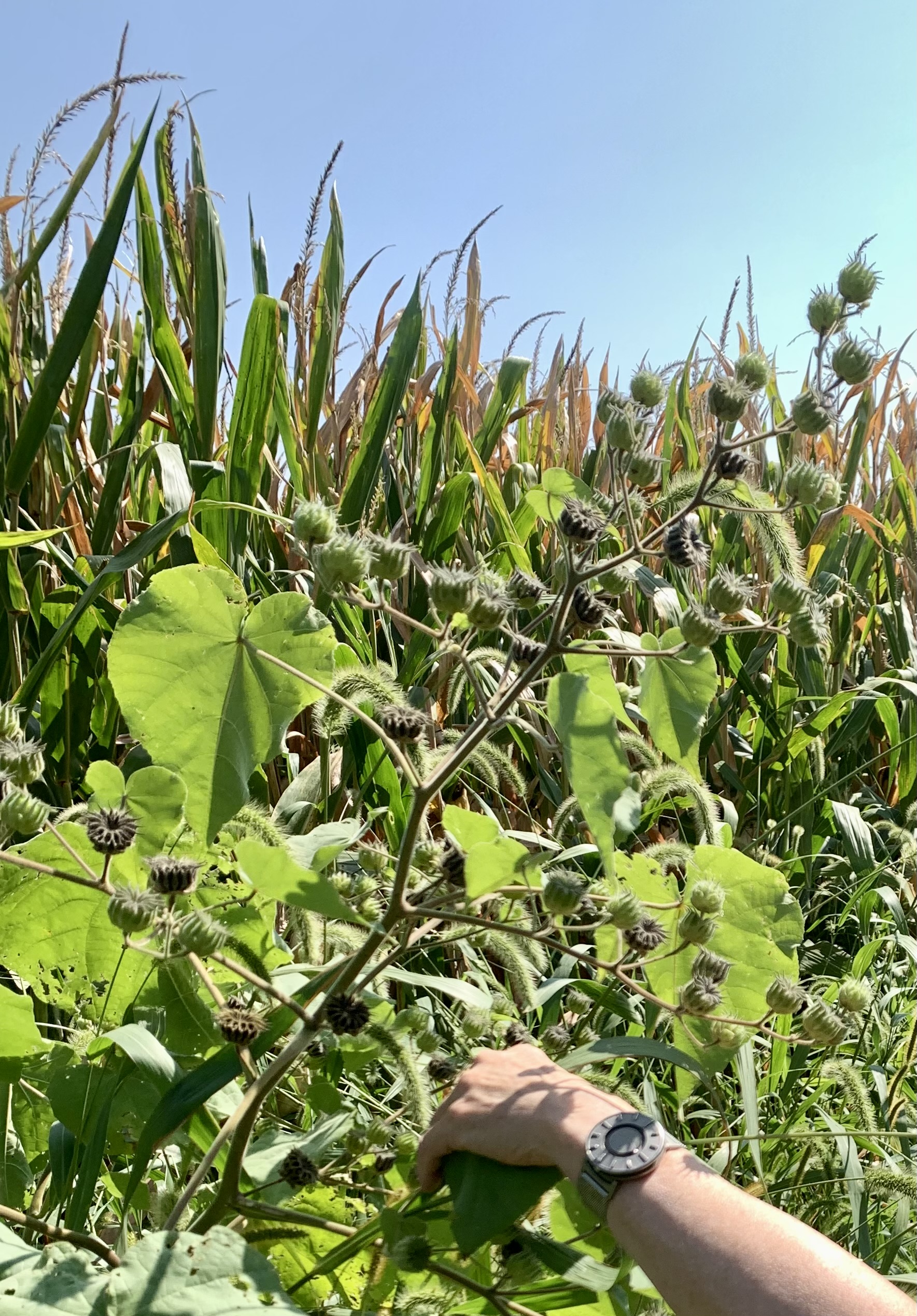When I was growing up on an Iowa farm, I thought velvetleaf was a most lovely plant. Its leaves were so velvety soft to the touch. It was so soft I’d want to rub it on my cheek. Even the stems were velvety. And the coolest part was the buttons that formed in the fall. We called it velvetleaf or buttonweed, and my dad was far less enamored with it than I was. He considered it a noxious weed and worked hard to keep it out of the corn and bean fields.
The story of this plant traces its path from much-loved and cultivated to noxious weed and enemy number one. Originating in either China or India, velvetleaf (Abutilon theophrasti) has been cultivated for over 4,000 years in China. The fiber in its stems was and still is used to make rope, nets, coarse cloth, paper and caulk for boats. In the 1600s, velvetleaf was introduced into North America to fill the settlers’ need for fiber. It was intentionally cultivated for its fiber over the next hundred years and spread prolifically on the eastern seaboard. It never was a commercial success, though. It earned many names, including elephant ears due to its leaf shape; butterprint or buttonweed due to its unique seed capsules. It has also been called cottonweed, China jute, abutilon hemp, Manchurian jute, and American jute because of its use as a source for fiber.
Velvetleaf is an upright plant that colonizes disturbed soils. It grows up to eight feet tall. Its leaves are heart-shaped and pointed at the end. Leaves and stems are covered with very fine hairs that make it so velvety soft. It flowers in mid to late summer with five-petaled orange-yellow flowers. By September, the flowers have given way to its interesting seed capsules. Each capsule (or button) is about an inch across and looks like a little pie with a fluted edge and little spines sticking up around the top edge. They rattle when they dry because each one contains up to 50 flat, grayish-brown seeds about one-eighth inch long. Each mature plant can produce up to 17,000 seeds, and the capsules may remain on the plant throughout the winter providing food. No wonder they spread so much.
Velvetleaf is a tenacious and aggressive plant that will crowd out corn and beans, robbing the crops of water and nutrients. With an average of 2.5 to 5 velvetleaf plants per square meter, yields in a bean field will drop by as much as 40%. Corn, cotton, peanuts, sugar beets, alfalfa and tobacco are similarly affected. So it’s war.
The velvetleaf has several strategies that it uses to flourish and spread. First of all, it produces copious seeds. Birds and small mammals eat the seeds. The seeds have a hard coating which helps them survive a mouse’s digestive tract, so it remains viable after the mouse drops it in a new location. This helps spread the velvetleaf. The seeds can also lie dormant in the soil for up to 50 years, waiting for the right conditions to germinate.
Velvetleaf uses chemical warfare as well. The plant produces chemicals that, when washed into the soil, inhibit the germination and growth of other plants nearby. The seeds and seed coats also contain chemicals and microbes that inhibit bacterial and fungal growth, protecting the viability of the seeds.
Other strategies are physical. Velvetleaf develops a tough, fibrous root system with a deep taproot. It also grows faster than corn and is thus able to crowd out the crop plants and get first dibs on the available water and nutrients. This root system also makes it hard to dislodge the plant once it’s established. Velvetleaf germinates throughout the summer and is also shade-tolerant, so if it germinates after the crop is established, it can continue to flower and produce seeds under the corn canopy.
One further strategy is evolutionary. Strains of velvetleaf are becoming resistant to herbicides.
On the farmers’ side of the battle, multiple strategies are in play as well. The most obvious is herbicides. Currently over 200 different products are on the market to control velvetleaf, and farmers spend millions of dollars each year in their battle against the plant. Management strategies also include no-till farming, which causes the seeds to germinate on the surface and die rather than germinating at the ideal depth of two inches. Mowing and hoeing before they flower helps keep them under control, as does rotating crops every year.
Research on biological controls is also underway. Insects such as corn earworm, tobacco budworm, velvetleaf seed beetle, and two plant bugs feed on velvetleaf. However, they also feed on crops. A plethora of fungi and bacteria attack the plants in various ways, but these options may have serious side effects in the field.
And so the war continues.
Photo by Author. Alt text: Velvetleaf in the summer sun. Heart-shaped leaves and branching stems, terminating in the button-shaped seed capsules that give the plant its common name, buttonweed.

2 comments
Buttonweed was a friend to de-tasslers!
Please, tell me more. How did that work?